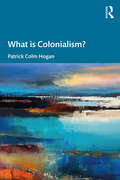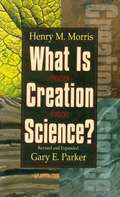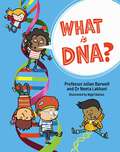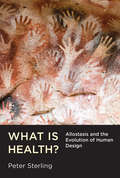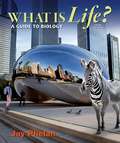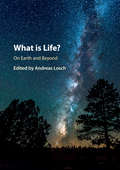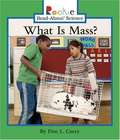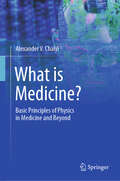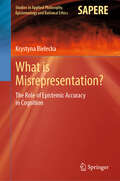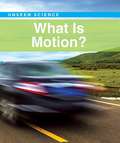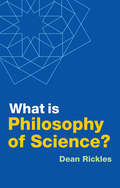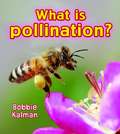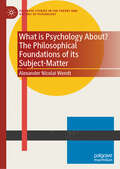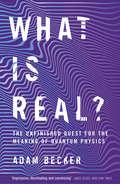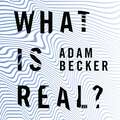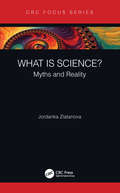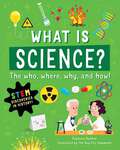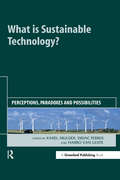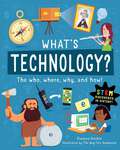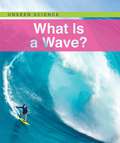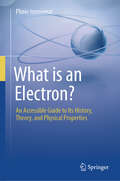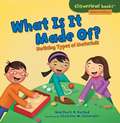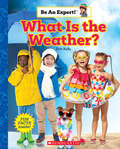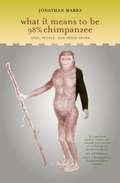- Table View
- List View
What is Colonialism?
by Patrick Colm HoganWhat is Colonialism? develops a clear and rigorous account of what colonialism is and how it works. It draws on and synthesizes recent work in cognitive science, affective science, and social psychology, along with Marxism and related forms of analysis. Hogan begins with some fundamental conceptual distinctions, such as the degree to which a group shares beliefs, dispositions, and skills versus the degree to which they share identification with a category. Building on these distinctions, he defines colonialism in terms of political, economic, and cultural autonomy, clarifying the nature of culture and autonomy particularly. He goes on to articulate an invaluable systematic account of the varieties of colonialism. The final chapters outline the motives of imperialists, differentiating these from their ideological rationalizations, and sketching the harms caused by colonialism. The book concludes by considering when, or if, one can achieve a genuinely postcolonial condition. Hogan illustrates these analyses by examining influential literary works—by European writers (such as Joseph Conrad) and by non-Europeans (such as Athol Fugard, Kamala Markandaya, and Wole Soyinka). This accessible and informative volume is the ideal resource for students and scholars interested in colonialism and empire.
What is Creation Science?
by Dr Henry M. Morris Dr Gary ParkerWhat is the better explanation? Many Christians are not aware that a growing number of legitimate scientists now embrace the Genesis explanation of origins. In What is Creation Science, two of the most respected members of that group have given us the benefit of their knowledge: Dr. Henry Morris, who has served on the faculties of five universities, Dr. Gary Parker, a former evolutionary biologist. Their findings throw the brakes on the "evolution train."
What is DNA?
by Professor Julian Barwell Dr Neeta LakhaniA humorous introduction to DNA and genetics, helping children find out what they are made of!DNA is the building block of all life. This book helps children aged 8 plus understand the structure of the DNA chemical, how it works inside the body, how life began on Earth and how all living things are connected by their DNA. With Nigel Baines' hilarious cartoons, the book explores topics such as why some of us really don't like Brussel sprouts - and why some of us love them!; what came first - the chicken or the egg?; and how DNA can solve crimes and make our lives better.Contents: The Great Discovery! / The Code Breakers and the Machines Inside Our Bodies / Babies Come with Instructions / Is it Good to Mix Up Our DNA? / How are Twins Made? / How Did Life on Earth Begin? / What Came First - the Chicken or the Egg? / Are We 50% a Mushroom?/ Is Grandad Really a Dinosaur?/ Why Don't I Like Vegetables?/ How Did I Get Ginger Hair?/ How Much Do Our Genes Affect Us?/ Spot a Relative After 500 Years!/ Traffic Lights - Red! Green! Blue?/ Gene On, Gene Off/ DNA That Makes Diseases / Who Did It!? / Who Is In Charge? / Quiz
What is Health?: Allostasis and the Evolution of Human Design
by Peter SterlingAn argument that health is optimal responsiveness and is often best treated at the system level. Medical education centers on the venerable “no-fault” concept of homeostasis, whereby local mechanisms impose constancy by correcting errors, and the brain serves mainly for emergencies. Yet, it turns out that most parameters are not constant; moreover, despite the importance of local mechanisms, the brain is definitely in charge. In this book, the eminent neuroscientist Peter Sterling describes a broader concept: allostasis (coined by Sterling and Joseph Eyer in the 1980s), whereby the brain anticipates needs and efficiently mobilizes supplies to prevent errors. Allostasis evolved early, Sterling explains, to optimize energy efficiency, relying heavily on brain circuits that deliver a brief reward for each positive surprise. Modern life so reduces the opportunities for surprise that we are driven to seek it in consumption: bigger burgers, more opioids, and innumerable activities that involve higher carbon emissions. The consequences include addiction, obesity, type 2 diabetes, and climate change. Sterling concludes that solutions must go beyond the merely technical to restore possibilities for daily small rewards and revivify the capacities for egalitarianism that were hard-wired into our nature. Sterling explains that allostasis offers what is not found in any medical textbook: principled definitions of health and disease: health as the capacity for adaptive variation and disease as shrinkage of that capacity. Sterling argues that since health is optimal responsiveness, many significant conditions are best treated at the system level.
What is Life?
by Erwin SchrödingerNobel laureate Erwin Schrödinger's What is Life? is one of the great science classics of the twentieth century. It was written for the layman, but proved to be one of the spurs to the birth of molecular biology and the subsequent discovery of DNA. What is Life? appears here together with Mind and Matter, his essay investigating a relationship which has eluded and puzzled philosophers since the earliest times. Brought together with these two classics are Schrödinger's autobiographical sketches, which offer a fascinating account of his life as a background to his scientific writings.
What is Life? A Guide to Biology
by Jay PhelanThis Biology book presents all the important topics under the following sections : The Facts of Life,Genetics, Evolution, and Behaviour, Evolution and the Diversity of life,Ecology and the Environment.
What is Life? On Earth and Beyond: On Earth and Beyond
by Andreas LoschApproaches from the sciences, philosophy and theology, including the emerging field of astrobiology, can provide fresh perspectives to the age-old question 'What is Life?'. Has the secret of life been unveiled and is it nothing more than physical chemistry? Modern philosophers will ask if we can even define life at all, as we still don't know much about its origins here on Earth. Others regard life as something that cannot simply be reduced to just physics and chemistry, while biologists emphasize the historical component intrinsic to life on Earth. How can theology constructively interpret scientific findings? Can it contribute constructively to scientific discussions? Written for a broad interdisciplinary audience, this probing volume discusses life, intelligence and more against the background of contemporary biology and the wider contexts of astrobiology and cosmology. It also considers the challenging implications for science and theology if extraterrestrial life is discovered in the future.
What is Mass? (Rookie Read-about Science)
by Don L. CurryThis Rookie Read-About® Science book introduces young readers to mass. Colorful photos and simple text encourage children to read on their own as they learn that everything has mass, and that things made up of more matter have more mass.
What is Medicine?: Basic Principles of Physics in Medicine and Beyond
by Alexander V. ChalyiThis book looks into the world of medicine through a unique lens - the principles of physics. Beginning with a brief history of medical physics and Feynman's classification of natural phenomena, it delves into topics such as the electrical activity of cells, and the physical basis of synaptic transmission, using nonlinear models that reveal their behavior as a strange attractor. Using a synergetic analogy between similar processes occurring in physical and neurophysiological systems, the author is able to formulate the first principle describing the emergence of hexagonal grid cells structures in the brain. It also explores the use of thermal imaging in the diagnosis, the dosimetry of ionizing radiation, and the physical basis of effective methods of quantum mechanics in modern medicine. Through detailed discussion of topics including synergetics, physiology, neurology, and radiation medicine, the reader gains a deep understanding of the physics behind medical diagnostics and treatments. Each chapter is devoted to exploring one of the directions of theoretical or clinical medicine, featuring parts written on different popular and rigorous physical levels. Providing a comprehensive overview of the physical principles of medicine and how they relate to medical equipment and technology, this book is a bridge between the fields of medicine and physics, demonstrating how the two can work together to advance the science of healthcare. This book is a valuable resource for anyone interested in the intersection of medicine and physics and the possibilities for future innovation.
What is Misrepresentation?: The Role of Epistemic Accuracy in Cognition (Studies in Applied Philosophy, Epistemology and Rational Ethics #71)
by Krystyna BieleckaThis book aims to justify and systematize the desiderata that a satisfying philosophical account of mental representations should meet, which is consistent with common-sense practice and scientific research. According to the author, the most important aspect of any satisfactory account of mental representation is the ability to determine that a given representation is incorrect and to identify the nature of the error. The book analyzes selected contemporary theories of mental representations with respect to major desiderata as well as the minor desiderata that they subsume, discussing the requirements for the philosophical accounts of particular types of mental representations. Since none of the previously proposed concepts meet this requirement satisfactorily, the author proposes an alternative theory of misrepresentation, which is based on the idea that epistemic accuracy is what minds care about. According to the author’s findings, cognitive systems rely on complex devices to check for coherence between these representations. In turn, the ideas presented here support the active role of mental representation in practice as an error-checking device in agreement with previous teleosemantics accounts.
What is Motion? (Unseen Science)
by Laura L. SullivanWhat Is Motion? introduces readers to the science behind that question, explaining the physics behind the phenomenon through graphs and activities. Easy-to-understand summaries following each chapter highlights the most important points for review
What is Philosophy of Science? (What is Philosophy?)
by Dean RicklesPhilosophy of science puts science itself under the microscope: What exactly is science? How do its explanations of the world differ from those of other subjects, including so-called “pseudo-sciences”? How should we understand and evaluate scientific methods? What, if anything, can science tell us about the nature of physical reality?Dean Rickles guides beginners through the central topics in philosophy of science. He looks at the origins and evolution of the field, the issues that arise when distinguishing between science and non-science, the concepts of logic and associated problems, scientific realism and anti-realism, and the nature of scientific models and representing. Rickles brings the subject to sparkling life with a user-friendly tone and rich, real-world examples.What is Philosophy of Science? is the must-have primer for students getting to grips with this broad-ranging and important topic.
What is Pollination? (Big Science Ideas #13)
by Bobbie KalmanPollination by insects is a critical function of all land ecosystems. Most orchard fruits, vegetables, and some field crops are pollinated by insects. This book features photographs that focus on the critical fact that protecting pollinators means having food to eat. It helps children look at insects in a different way. <P><P>Lexile Measure: 830
What is Psychology About? The Philosophical Foundations of its Subject-Matter (Palgrave Studies in the Theory and History of Psychology)
by Alexander Nicolai WendtThis book examines the subject-matter of psychology against the background of the philosophical problem of reality. It locates the core of the issue in the dualistic conception of reality which, it argues, has left psychologists with a conceptually constrained choice of subject-matter, for instance between experience and behavior, not to mention philosophically incomplete ways of discussing its possible subject-matters. By drawing on the work of philosophers and philosophically informed psychologists, the book seeks to explain and advance the long-standing debate by introducing the under-utilized perspective of ideal-realism. The historical origins and trajectory of ideal-realism are recovered from the late 18th century through the early 20th century. The exposition of this tradition, especially in the little-known German Realpsychologie, provides theoretical psychology with a philosophically founded understanding of its subject-matter.
What is Real?: The Unfinished Quest for the Meaning of Quantum Physics
by Adam BeckerEvery physicist agrees quantum mechanics is among humanity's finest scientific achievements. But ask what it means, and the result will be a brawl. For a century, most physicists have followed Niels Bohr's Copenhagen interpretation and dismissed questions about the reality underlying quantum physics as meaningless. A mishmash of solipsism and poor reasoning, Copenhagen endured, as Bohr's students vigorously protected his legacy, and the physics community favoured practical experiments over philosophical arguments. As a result, questioning the status quo long meant professional ruin. And yet, from the 1920s to today, physicists like John Bell, David Bohm, and Hugh Everett persisted in seeking the true meaning of quantum mechanics. What is Real? is the gripping story of this battle of ideas and the courageous scientists who dared to stand up for truth.
What is Real?: The Unfinished Quest for the Meaning of Quantum Physics
by Adam BeckerThe untold story of the heretical thinkers who challenged the establishment to rethink quantum physics and the nature of reality.Every physicist agrees quantum mechanics is among humanity's finest scientific achievements. But ask what it means, and the result will be a brawl. For a century, most physicists have followed Niels Bohr's Copenhagen interpretation and dismissed questions about the reality underlying quantum physics as meaningless. A mishmash of solipsism and poor reasoning, Copenhagen endured, as Bohr's students vigorously protected his legacy, and the physics community favoured practical experiments over philosophical arguments. As a result, questioning the status quo long meant professional ruin. And yet, from the 1920s to today, physicists like John Bell, David Bohm, and Hugh Everett persisted in seeking the true meaning of quantum mechanics. What is Real? is the gripping story of this battle of ideas and the courageous scientists who dared to stand up for truth.(P)2018 Blackstone Audio, Inc
What is Science?: Myths and Reality
by Jordanka ZlatanovaIn a multitude of ways, science affects the life of almost every person on earth. From medicine and nutrition to communication and transportation, the products of scientific research have changed human life. These changes have mostly taken place in the last two centuries, so rapidly that the average person is unable to keep informed. A consequence of this "information gap" has been the increasing suspicion of science and scientists. The lack of true understanding of science, especially of "fundamental" research, motivates this effort to narrow this gap by explaining scientific endeavor and the data-driven worldviews of scientists. Key Features Fills an existing void in the understanding of science among the general population Is written in a nontechnical language to facilitate understanding Covers a wide range of science-related subjects: The value of "basic research" How scientists work by sharing results and ideas How science is funded by governments and private entities Addresses the possible dangers of research and how society deals with such risks Expresses the viewpoint of an author with extensive experience working in laboratories all over the world
What is Science?: The Who, Where, Why, and How
by Frances DurkinFact-filled non-fiction that uncovers the who, where, why, and how of amazing scientific discoveries throughout history.From the explosion at the start of the universe to atomic energy and the impact of immunization the contents focus on the people behind the science and the history happening at the time. Included within the book is a contents list at the front and a glossary at the back plus a "take it further" activity on each page. Discover the human side of STEM!
What is Sustainable Technology?: Perceptions, Paradoxes and Possibilities
by Karel Mulder Didac Ferrer Harro van LenteDesigners of technology have a major responsibility in the current age. Their designs can have tremendous effects on society, in both the short and the long term. In fact, sustainable development itself has all the characteristics of a design project, albeit a vast one. But a failed product design here will be not just be unsuccessful in the market – it will have far-reaching consequences. It is our common responsibility to make the project successful. Technology has played an important role in creating the problems that we now face; but it will also play an important role in solving them. But this does not mean the technological fix will be easy. How do we allocate resources and attention when there are myriad issues under the umbrella of "sustainable development" currently in competition with one another? How do we arrive at precise specifications for the sustainable technologies that are to be developed and, furthermore, reach consensus on these specifications? What if our sustainable technological solutions aggravate other problems or create new ones? And, because sustainable development is all about the long-term consequences of our actions, how do we assess the effects of modifying existing landscapes, infrastructures and patterns of life?How could we be sure in advance that the changes that new technologies bring will make our society more sustainable? These dilemmas and paradoxes are the subject of this provocative book. Sometimes the claim that a technology is sustainable is made in order to make the technology acceptable in the political process, as in the case of nuclear energy production, where the claims of "sustainability" refer to the absence of CO2 emissions. In the case of biofuels, claims of sustainability have led to a "fuel or food" debate, showing that sustainability has counteracting articulations. And the well-known rebound effect is observed when increased resource efficiency can create a stimulus for consumption. What is Sustainable Technology? illustrates that the sustainability impact of a technology is often much more complicated and ambivalent than one might expect. Making improvements to existing designs is not the technological challenge that will lead to real solutions. We mustn't look to change a part of a machine, but rather the machine as a whole – or even the whole system in which it functions. It is these system innovations that have the potential to make a genuine contribution to sustainable development. What is Sustainable Technology? will help all those involved in designing more sustainable technologies in determining their strategies. It does so by presenting case studies of different technologies in contrasting contexts. Each case asks: 1. What articulations of sustainability played a role in the design process? 2. What sustainability effects did this technology lead to? 3. Who was affected, where, and when? 4. Could the designer have foreseen these consequences? 5. How did the designer anticipate them? 6. How was societal interaction dealt with during the design process? Finally, the authors reflect on future options for the sustainable technology designer. They argue that an important first step is an awareness of the multitude of sustainable development challenges that play a role in production, use, recycling and end-of-life disposal. What is Sustainable Technology? will be essential reading for product designers, engineers, material scientists and others involved in the development of sustainable technologies, as well as a wide academic audience interested in the complexities of the sustainable design process.
What is Technology?: The Who, Where, Why, and How
by Frances DurkinFact-filled non-fiction that uncovers the who where why and how of amazing technological inventions throughout history. From the magic of making music to lightbulb moments and tiny technology the contents focus on the people behind the inventions and the history happening at the time. There is a contents list at the front of the book and a glossary at the back plus a "take it further" activity on each page. Discover the human side of STEM!
What is a Wave? (Unseen Science)
by Linda IvancicWhat Is a Wave? introduces readers to the science behind that question, explaining the physics behind the phenomenon through graphs and activities. Easy-to-understand summaries following each chapter highlights the most important points for review.
What is an Electron?: An Accessible Guide to Its History, Theory, and Physical Properties
by Plinio InnocenziThis book offers an in-depth exploration of one of the fundamental particles that has shaped our understanding of the physical world and revolutionized technology, combining historical narrative with rigorous scientific analysis to provide a comprehensive account of the electron. Starting from the early atomic models of Democritus and Dalton, the book traces the journey through key experiments such as J.J. Thomson's discovery of the electron, Rutherford's model, and Bohr's contributions. It discusses how these foundational experiments and theories have paved the way for modern quantum mechanics. Each chapter looks at significant milestones, from the photoelectric effect and the discovery of electron spin to quantum tunneling and entanglement. The book also addresses the electron’s strange properties and its relatives, such as positrons, muons, and tau particles, providing a detailed examination of their roles in the broader context of quantum field theory. The author draws from original sources to ensure accuracy and authenticity, making this work a reliable reference for students and enthusiasts alike. The text is written in accessible language, carefully explaining complex concepts without overwhelming the reader with intricate mathematical formulations. With many illustrative figures, "What is an Electron?" serves as an essential resource for undergraduate students in physics, chemistry, and materials science, as well as for scientifically-curious readers eager to understand the profound implications of electron behavior in quantum mechanics and modern technology.
What is it made of: Noticing Types of Materials
by Martha E. H. RustadListening and Exploration: Helping Clients Identify Their Experiences, Issues, and Problems; Clarification: Helping Clients Clarify Their Experiences and Develop Goals; Action: Helping Clients Take Action; Effective Communication: Facilitating Exploration, Clarification, and Action.
What is the Weather? (Be an Expert!)
by Erin KellyKids love to be the experts! Now they can feel like real pros with this exciting nonfiction series for beginning readers. Kids will be hooked on the thrilling real-world topics and big, bright photos. Each book features simple sentences and sight words that children can practice reading. Then, with support, kids can dig deeper into the extra facts, Q&As, and fun challenges.Fans of this series will be eager to become real experts!Sometimes it is cold outside. We have to bundle up. Sometimes it is hot. We don’t even need a coat. The weather is always changing! What do you know about days that are sunny, cold, rainy, or dry? With this book you can become an expert!
What it Means to be 98% Chimpanzee: Apes, People and Their Genes
by Jonathan MarksA molecular anthropologist explores the production of knowledge claims about genetics, especially as they relate to inter-species similarities and race.
